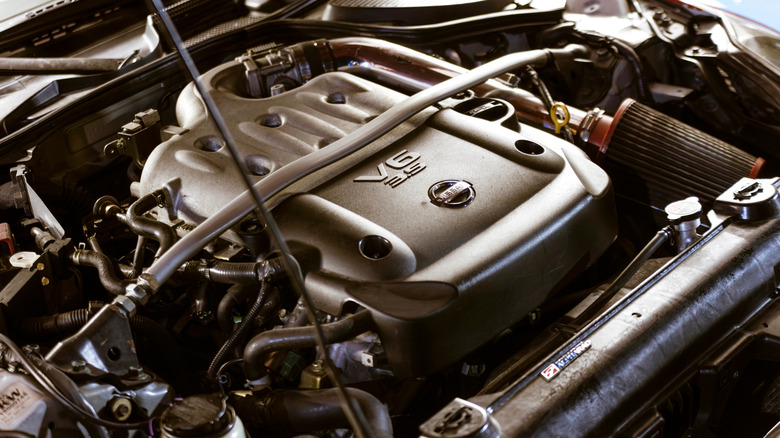Why Do V6 And V8 Engines Sound So Different?
The sounds of the automotive world are as diverse as the cars from which they emanate, with certain engine notes being almost instantly identifiable. For instance, there's no mistaking the deep, savage growl of a classic 426 Hemi V8, or the trumpet-like bellowing of the Nissan GT-R's V6 at full tilt — particularly the special R35 version. Some manufacturers consider an engine's sound integral to the car's identity, even labeling it an art form. But that doesn't answer one fundamental question: They're all internal combustion engines, so why do they sound so different from one another?
The explanation is far more complicated than, "Because a V8 has two extra cylinders." V8 engines produce a great range of notes and so do V6s. For instance, a newer Ferrari's V8 sounds completely different from a modern muscle car of similar vintage. To understand acoustic differences between V8s, V6s, and other kinds of engines, one must consider how and when an engine functions.
Firing order, crankshaft type, intake and exhaust, and camshaft profile all affect engine notes. V6 and V8 engines feature different balancing characteristics and firing orders, which means that the explosions inside the engines occur at different rates and intervals. This produces a different resonant sound frequency further differentiated by all the aforementioned factors, leading to the two engine configurations producing vastly different notes. Let's explore the physics behind how each engine functions and why they sound the way they do.
The science behind audio frequencies and vibrations
The underlying physics of sound frequencies is an incredibly complex topic associated with the specialized field of audio engineering –- basically, well beyond the scope of this article. To keep it simple, let's think of the V6 in complete isolation from the exhaust, intake, sound-deadening, and anything that could influence its inherent sound. At its core, an engine produces sound through pressure waves that produce a flat sound. However, this is where we introduce the cylinder count. Note that this doesn't apply to a VR6 configuration, which is different to a V6 in several ways.
Every rotation V6 crankshaft manipulates six different pistons in a specific order, and those pistons will be at differing stages of their strokes. Because there are fewer pistons, this means that, on average, there are fewer explosions per single revolution of the crankshaft. Moreover, these pistons will fire at different intervals than a V8's. A pressure wave is produced each time they fire, meaning fewer pressure waves are resonating through the headers of a V6 than a V8 per revolution.
These pressure waves produce a specific frequency, and those frequencies can interact with one another like chords while strumming a guitar. This lends the V6 its inherent base frequency, which is then modified through all the other factors like intake, exhaust, cam profile, and so on. Furthermore, because a V6 features an odd number of cylinders per bank, there's an inherent imbalance of forces moving up and down. This produces associated vibrations that must be canceled out with balancing shafts, further distorting the natural pressure wave's sound.
Engine geometry and sound
Next, let's look at the V8's inherent characteristics and how these create its specific sound. V8s come in two major configurations based on the orientation of the crankshaft: cross-plane or flat-plane. These produce specific sounds, with the cross-plane being the traditional muscle car and the flat-plane the exotic European V8.
Viewed head-on, the cross-plane crankshaft looks like a cross, with two pins every 90 degrees. Its design ensures there are always two cylinders moving upwards for every 90 degrees of rotation, with one cylinder on the power stroke. This quality lends the cross-plane V8 its characteristic note, with the sound caused by the cross-plane firing order. The banks don't take turns firing cylinders — instead, they feature an odd firing sequence to achieve their equally timed firing order. Let's use the basic Chevy small-block as an example. The firing order is 1-8-4-3-6-5-7-2, which, when translated into which side fires, becomes L-R-R-L-R-L-L-R. Note the paired sides – that's what provides that distinctive grunt-like note compared to a flat-plane or V6, which usually alternate which bank fires.
Lastly, another prominent sound influence is an engine's bank angle, meaning the angle of the "V" between each cylinder bank. This determines when a cylinder will reach top dead center and be ready to ignite. V6 and V8 configurations each have their own optimal bank angles determined by the shape of the crankshaft; deviating from this leads to an odd-firing engine. V6 engines typically use a 60-degree bank angle like this common GM V6 that powered numerous Pontiacs (though some V6 engines use 90-degree angles), allowing the cylinder banks to exchange power strokes evenly, producing a smoother exhaust note than the cross-plane V8.


